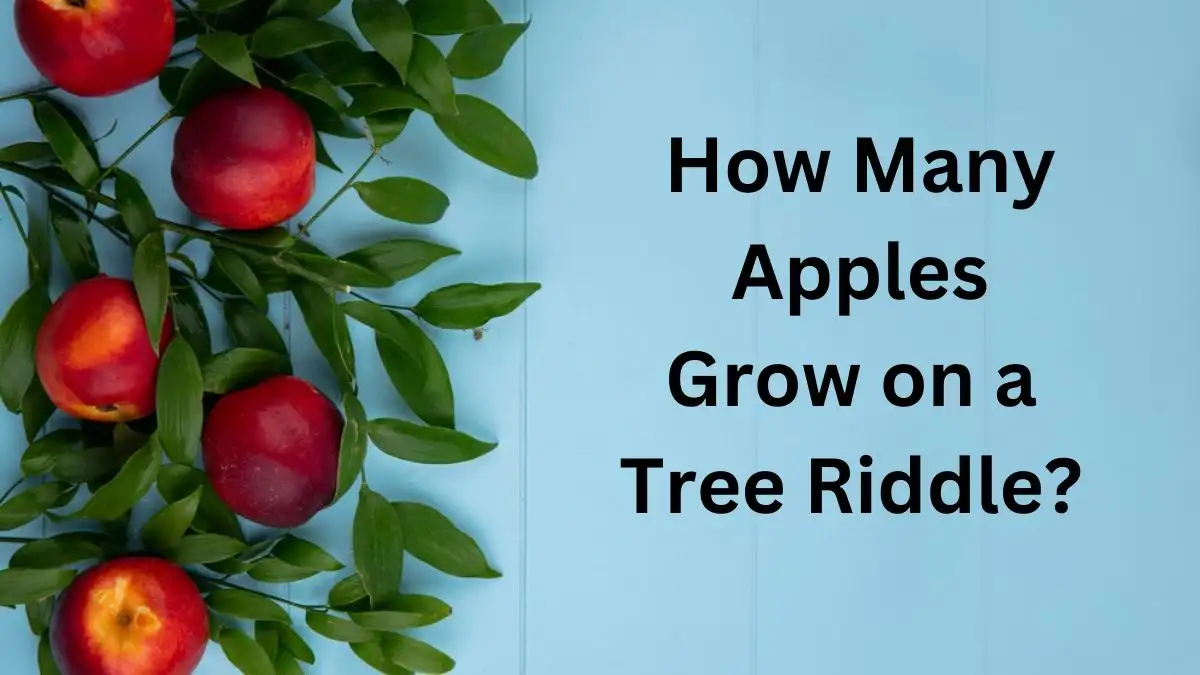How Many Apples Grow on a Tree Riddle? Answer Solved and Explained
by Priyanka P
Updated Feb 28, 2024

How Many Apples Grow On a Tree Riddle
Imagine a tall and sturdy tree standing in a vast orchard, its branches stretching outwards like welcoming arms. Among its lush green leaves, small buds begin to form, promising the arrival of something special. As days pass and the sun's warmth envelops the tree, these buds gradually transform into tiny fruits, round and vibrant.
Each apple starts as a delicate blossom, kissed by the gentle spring breeze. As the seasons change, these blossoms mature into small, green orbs, slowly but surely growing in size and weight. With each passing day, the tree works tirelessly, drawing nutrients from the soil and water from the earth to nurture its precious fruit.
Soon, the branches become adorned with countless apples, their colors ranging from deep reds to bright yellows, each one a testament to the tree's dedication and care. Some apples hang low, within easy reach, while others sway gently in the breeze, tempting those who dare to climb higher.
As autumn arrives and the air turns crisp, the apples ripen, their flavors becoming sweeter with each passing day. People from far and wide come to admire the tree's bounty, marveling at the abundance it provides.So, how many apples grow on a tree? Well, that's a question with a simple answer, yet one that holds a world of wonder within it.
Dive into the enigmatic world of riddles where we unravel the mysteries behind these captivating puzzles and provide solutions that enlighten and entertain. Follow Fresherslive to get all the latest riddle answers.
How Many Apples Grow On a Tree Riddle Explained
The riddle "How many apples grow on a tree?" may seem straightforward, but its answer holds a clever twist. When someone asks this question, they're not looking for a specific number of apples. Instead, they're prompting you to think about the nature of apple trees and their fruit-bearing capacity.
The answer, "All of them," plays on the fact that typically, all the apples that a tree produces will indeed grow on the tree itself. This answer highlights the idea that an apple tree's purpose is to bear fruit, and if it's healthy and thriving, it will produce as many apples as its branches can support.
By saying "All of them," the riddle emphasizes the abundance of apples that a healthy apple tree can yield. It's a playful way of acknowledging the productivity and generosity of nature. Additionally, it encourages us to appreciate the marvel of fruit-bearing trees and the bounty they provide.
So, while the answer may seem simple, it cleverly invites us to ponder the wonder of nature's abundance and the remarkable capacity of trees to bear fruit.
What is Riddle?
A riddle is like a fun puzzle made with words. It's a game where someone says something tricky or asks a question, but there's a secret meaning hidden inside. The aim is to make others think hard and figure out the answer.Riddles come in all shapes and sizes.
Sometimes they're simple wordplay, and other times they're more complicated tricks with language. The point is to challenge people to use their brains and imagination to find the right answer. They often use words in clever ways or have two meanings to lead you to the solution.
People have been enjoying riddles for a long time. They show up in stories, books, and even in conversations. Riddles aren't just for fun; they also help our minds stay sharp by making us think in new ways and consider different ideas.So, when someone tells you a riddle, it's like they're inviting you on a journey of thought. The joy isn't just in getting the answer right but in the adventure of figuring it out.
Advantages of Solving Riddle
- Cognitive Exercise:
- Solving riddles stimulates the brain, providing a mental workout that enhances cognitive abilities.
- Engaging with the challenge of deciphering the hidden meaning or pattern improves problem-solving skills and critical thinking.
- Language Skills:
- Riddles often involve wordplay, puns, and clever language usage, contributing to the development and enrichment of vocabulary.
- Regular exposure to riddles can enhance linguistic creativity and proficiency.
- Creativity Boost:
- The process of solving riddles encourages individuals to think outside the box, fostering creativity and imagination.
- It prompts unconventional thinking as individuals explore various possibilities to arrive at the correct solution.
- Entertainment and Fun:
- Solving riddles is an enjoyable activity, providing a source of entertainment and amusement.
- It can be a social activity, promoting interaction and friendly competition among individuals or groups.
- Educational Value:
- Riddles often convey cultural or historical insights, offering a playful way to learn about language, traditions, and societal aspects.
- They can be incorporated into educational settings to make learning more engaging.
- Boosts Confidence:
- Successfully solving a challenging riddle can instill a sense of accomplishment and boost self-confidence.
- It encourages perseverance and resilience when faced with mental challenges.
- Enhances Memory:
- Remembering and recalling the information embedded in a riddle contributes to memory improvement.
- The mental effort required for solving riddles can strengthen memory retention.
- Teaches Logical Reasoning:
- Riddles often have a logical structure, requiring individuals to follow a sequence of thoughts or deductions to arrive at the answer.
- This fosters the development of logical reasoning skills.
How Many Apples Grow on a Tree Riddle? - FAQs
All of them, implying that all the apples produced by a tree grow on it.
The riddle highlights the abundance of apples a healthy tree can produce, emphasizing nature's generosity.
Apples start as blossoms, then develop into small green fruits that mature into the ripe apples we enjoy.
It suggests that every apple a tree produces grows on its branches, showcasing nature's productivity.
It prompts reflection on the fruitful capacity of trees in a playful and thought-provoking manner.







